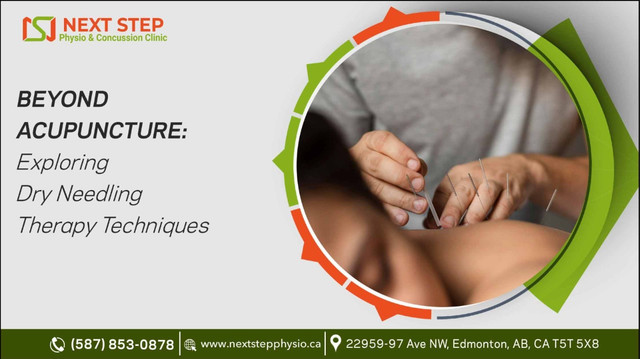
Dry needling therapy is a highly effective and specialized treatment technique that targets muscle pain and dysfunction. This therapy uses thin, solid needles to release tight muscle knots (also known as trigger points) and promote healing in soft tissues. dry needling therapy Edmonton At Next Step Physiotherapy , our skilled physiotherapists use dry needling as part of a comprehensive treatment plan to relieve pain, improve movement, and speed up recovery from musculoskeletal conditions.
The “dry” in dry needling refers to the fact that no medication is injected into the body during the procedure. Instead, the needle is used to create a therapeutic effect on the muscle or tissue. When the needle is inserted, it stimulates a response in the tissue, promoting healing and improving the muscle’s ability to contract and relax properly.
How Does Dry Needling Work?
The goal of dry needling is to alleviate pain and muscle dysfunction. When a trigger point is targeted by the needle, the muscle fibers are “stimulated” in a way that helps reduce the tightness and spasm in the area. This process encourages blood flow to the muscle, which accelerates the healing process and can help break the pain cycle.
Trigger points often develop due to factors like poor posture, repetitive movements, injury, or overuse of muscles. These areas of tension can lead to pain not only in the immediate muscle but also in other parts of the body, a phenomenon known as referred pain. By targeting these points, dry needling can release tension, improve flexibility, and restore normal muscle function.
Conditions Treated with Dry Needling
Dry needling is a versatile treatment option that can help manage a variety of conditions, including:
Chronic Pain: Conditions like fibromyalgia and chronic back pain can often be exacerbated by tight muscles and trigger points. Dry needling can provide significant relief by targeting these areas of tension.
Sports Injuries: Muscle strains, ligament sprains, and tendinitis can benefit from dry needling, which helps reduce muscle spasms, promote healing, and restore function.
Tension Headaches: Trigger points in the neck and shoulder area are often responsible for tension headaches. Dry needling can release these trigger points and reduce headache frequency and intensity.
Whiplash and Postural Issues: After a car accident or due to poor posture, the muscles in the neck and upper back may tighten. Dry needling can help relieve this discomfort and restore normal movement.
Joint Pain: Dry needling is commonly used in conjunction with other treatments to help reduce joint pain, particularly when muscle tightness is contributing to the issue.
What to Expect During a Dry Needling Session
During a dry needling session at Next Step Physiotherapy, your physiotherapist will first conduct an assessment to determine which muscles are causing pain or discomfort. They will then insert a thin, sterile needle into the targeted trigger point. You may experience a brief sensation of a muscle twitch, which is a normal and expected response to the needling.
Most patients find the procedure to be relatively quick, with minimal discomfort. While you may feel some soreness or tenderness in the treated area following the session, this is usually temporary and subsides within a day or two. Many people report significant pain relief and increased mobility after just a few treatments.
Benefits of Dry Needling
Relieves Muscle Tension: Dry needling effectively targets and releases muscle knots, alleviating pain and stiffness in tight muscles.
Improves Flexibility and Mobility: By reducing muscle tightness and promoting healing, dry needling can restore your range of motion and flexibility.
Accelerates Recovery: Whether recovering from a sports injury, car accident, or chronic condition, dry needling can speed up the healing process and reduce downtime.
Reduces Inflammation: Dry needling helps to increase blood flow to the affected areas, reducing inflammation and promoting tissue repair.
Is Dry Needling Safe?
Dry needling is a safe and effective treatment when performed by a trained physiotherapist. While there may be some mild discomfort during the procedure or soreness afterward, the risks associated with dry needling are minimal. Your physiotherapist at Next Step Physiotherapy will carefully assess your condition and discuss any concerns you may have before beginning treatment.
Conclusion
Dry needling is a highly effective therapy for treating muscle pain, tension, and dysfunction. Whether you’re recovering from an injury, managing chronic pain, or seeking to improve mobility, dry needling can help restore function and ease discomfort. At Next Step Physiotherapy in Edmonton, our experienced physiotherapists are here to guide you through your recovery with dry needling and other evidence-based treatments tailored to your specific needs.
#dryneedlingedmonton #dryneedlingnearme #dryneedlingtherapyedmonton #dryneedlingtherapy #dryneedlingtherapynearme #imstherapyedmonton #imstherapy #physicaltherapyedmonton #physicaltherapy #physiotherapy #physiotherapyedmonton #nextstepphysiotherapyedmonton #physicaltherapist #physiotherapyclinic #physioclinicedmonton